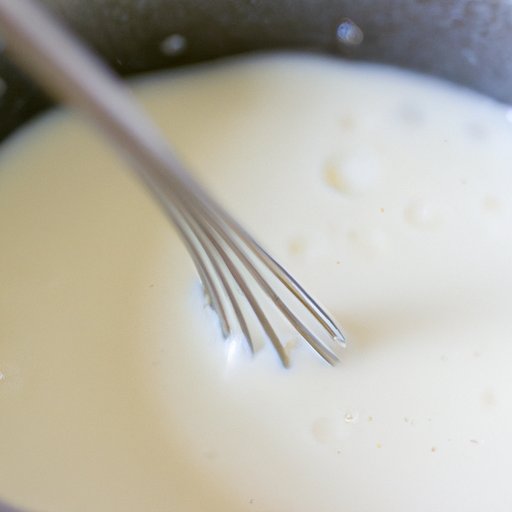Introduction
Have you ever been in the middle of whipping up something delicious in the kitchen, only to realize that you’re out of milk? It can be frustrating to think your recipe might be a flop just because you don’t have one ingredient on hand. But fear not! There are substitute options out there, and one that may surprise you is evaporated milk. In this article, we’ll explore the ins and outs of using evaporated milk instead of regular milk in cooking and baking.
Evaporated Milk vs Milk: Which One Should You Use?
Let’s start with the basics: what is the difference between evaporated milk and regular milk? Evaporated milk is canned milk that has had about 60% of its water removed through a heating process. This results in a thicker, more concentrated liquid that has a slightly caramelized, nutty flavor. In contrast, regular milk comes straight from a cow (or alternative milk source) and has not had any water removed.
So which one should you use in your recipes? It ultimately depends on what you’re making. Evaporated milk is often used in recipes that call for milk in order to add richness and depth of flavor. It can be a great addition to soups, sauces, and casseroles. Regular milk, on the other hand, is a good all-purpose option for recipes that just need a bit of liquid, such as baked goods and some sauces.
If you’re adding milk to your coffee, however, regular milk is the way to go – evaporated milk can be too thick and strongly flavored for this use.
Baking Hacks: How Evaporated Milk Can Substitute Regular Milk
So, you’ve decided to substitute evaporated milk for regular milk in your baking. What do you need to know to make the switch successfully?
Firstly, you’ll need to adjust the amounts of other ingredients in your recipe to make up for the change in liquid. Generally, you’ll use a 1:1 ratio of evaporated milk to regular milk, but you’ll need to reduce or remove the other liquid in the recipe accordingly. You might also need to add a bit of extra sugar.
For example, if a recipe calls for 1 cup of milk and you’re using evaporated milk instead, you can mix together 1/2 cup evaporated milk and 1/2 cup water to make up the one cup. You might also increase the amount of sugar in your recipe by a tablespoon or two to balance out the sweetness.
It’s important to note that evaporated milk is richer and more flavorful than regular milk, so this substitution will change the taste of your baked goods. For recipes where the milk plays a prominent role in the flavor, such as custards, puddings, and flans, evaporated milk can be a big improvement.
Save Money and Add Richness to Your Recipes with Evaporated Milk
Not only can evaporated milk be a great substitution for regular milk in your cooking and baking, but it can also save you money. This is because evaporated milk is cheaper than regular milk on a per-ounce basis, and it has a longer shelf life due to being canned.
In addition to cost savings, using evaporated milk can also add richness and creaminess to your recipes. For example, creamy soups and sauces can be enhanced with evaporated milk, giving them a more luxurious mouthfeel.
Avoid Recipe Fails: When to Use Evaporated Milk Instead of Milk
While evaporated milk can be a good all-around substitute for regular milk in many cases, there are some recipes where using evaporated milk specifically is important. For example, pumpkin pie recipes often call for evaporated milk in order to get a smooth and velvety texture. Similarly, fudge recipes often rely on evaporated milk for a creamy texture.
On the flip side, substituting regular milk for evaporated milk in these kinds of recipes can cause issues. For example, using regular milk instead of evaporated milk in fudge can result in a grainy texture. In general, if a recipe specifically calls for evaporated milk, it’s best to use it rather than trying to substitute.
No Milk, No Problem: How to Use Evaporated Milk for Everyday Cooking
Evaporated milk doesn’t have to be just a backup plan in case you run out of regular milk – it can be a useful ingredient in everyday cooking. For example, you can use it to add creaminess to oatmeal or smoothies without the added calories of cream or milk.
Another idea is to use evaporated milk as a creamer for your coffee. This can be especially handy if you don’t want to spend money on a separate creamer, or if you’re looking for a non-dairy option.
When it comes to storage and use of evaporated milk, keep in mind that it has a long shelf life if unopened (up to a year). Once opened, store it in an airtight container in the fridge and use it within a week.
Conclusion
In conclusion, evaporated milk can be a valuable substitute for regular milk in cooking and baking. While it’s not a perfect replacement in every scenario, it can add richness and depth of flavor to your recipes while also being cost-effective.
